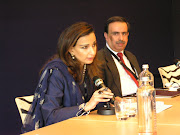The nuclear debate in India India India India India
The CTBT was adopted by the United Nations general assembly in September, 1996. About 150 States have ratified the CTBT and another 32 States have signed but not yet ratified it. But the treaty cannot come into force unless the 44 States listed in Annex 2 of the treaty have ratified it. Nine of these States have not ratified the treaty, including India , China , Iran , Israel , North Korea , Pakistan and the United States of America
At Prague Washington
The India India ’s permanent representative to the UN in Geneva , Arundhati Ghose, and a bhadramahila with a greater spine than most Indian diplomats, said: “Mr President, I would like to declare on the floor of this august assembly that India India had been included in Annex 2, without its consent, the draft had been negotiated outside the conference on disarmament (where India blocked a consensus) and that the treaty was not explicitly linked to a plan for disarmament which India India
On May 11 and 13, 1988, India
India quickly declared a unilateral moratorium on further testing, and New Delhi’s back channels seriously discussed signing the CTBT (as a way of normalizing relations and getting sanctions, imposed in the wake of the tests, lifted) with their American counterparts, but the Clinton administration was beset with its own problems. Then came the trouble-free Bush years. In March this year, however, the prime minister’s special envoy, Shyam Saran, said at a conference at the Brookings Institution at Washington
First, many consider thermonuclear or hydrogen weapons essential for building a credible deterrent. While this is debatable in terms of Indian nuclear deterrence strategy, there has always been scepticism about the thermonuclear claim. Days after the test, both the Central Intelligence Agency and the international scientific academic community expressed reservations. The well known nuclear-seismologist, then at the University of Arizona , Terry C. Wallace, openly rubbished India India
In response, the Indian atomic science establishment published its findings. Key figures of the atomic energy establishment, S.K. Sikka, Falguni Roy. and G.J. Nair, argued - in a referred paper — rather naïvely it now seems — that large variations in the seismic magnitude were because of the “cancellation and superimposition of signals from these explosions separated in space by about 1 km”. The DRDO official’s assertion implies that Sikka et al were, at the very least, magnifying their achievements.
But we must not overlook the traditional rivalry between institutions and individuals. All nuclear States have had rivalries within driven by personal idiosyncrasies and institutional loyalties. The famous rivalry between Edward Teller (the father of the hydrogen bomb) and J. Robert Oppenheimer (the leader of the Manhattan Project which produced the first atomic weapons) is legendary and irretrievably divided the two main American nuclear labs: Los Alamos and Lawrence Livermore. When Oppenheimer opposed the hydrogen bomb, Teller accused him of being a Soviet spy.
In India
Finally, of course, there are institutional interests. No organization will seek to undermine its own raison d’être. In the US , when the Clinton Los Alamos got the Dual-Axis Radiographic Hydrodynamic Test facility. Livermore
The fact is that we need oversight by an independent authority. In the US America
-Co-authored with Rajive Nayan, IDSA
(Source: The Telegraph, 03/09/2009)
-Co-authored with Rajive Nayan, IDSA
(Source: The Telegraph, 03/09/2009)







No comments:
Post a Comment